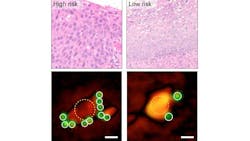Smartphones Functioning as Cancer-Detecting Microscopes
Researchers out of Massachusetts General Hospital (MGH) have developed a smartphone-based device that may accurately diagnosis tumors. Using the technology that creates holograms, the device collects microscopic images of the molecular composition of cells and tissues for digital analysis.
The device is called D3, or Digital Diffraction Diagnosis system. It features an imaging module with a battery-powered LED light that clips onto a smartphone. It records high-resolution imaging data and has a much greater field of view compared to a microscope. In a single image, the D3 can record data on more than 100,000 cells from a blood or tissue sample. For the molecular analysis of tumors, microbeads are added to the sample and bind to the cancer-related molecules and then loaded into the D3 imaging module. Once the image is recorded and transmitted to the server, the sample is analyzed by pinpointing the diffraction patterns generated by the microbeads. The numerical algorithm used by the D3 platform is capable of distinguishing the microbeads from the cells and analyzing the data at a rate of 10 MB of data in less than nine hundredths of a second.
Several pilot tests for accuracy were run. In the first pilot test, the presence of tumor proteins was detected in cancer-cell lines with an accuracy matching the current gold standard. The larger field of view simultaneously analyzed more than 100,000 cells at time. A second test was conducted analyzing cervical biopsy samples of 25 women with abnormal PAP smears. D3 analysis categorized the samples as high-risk, low-risk, or benign using microbeads tagged with antibodies against three published markers of cervical cancer. The results matched conventional pathologic analysis. D3 was also able to differentiate, from fine-needle lymph-node biopsy samples, four patients with lymphoma from another four patients with benign lymph-node enlargement. Finally D3 detected DNA, along with protein analyses, from human papilloma virus. In these pilot tests, the cost per assay was $1.80 and the results were available under an hour. Costs are expected to drop as the process becomes more refined.
Ralph Weissleder, M.D., PhD, director of the MGH Center for Systems Biology (CSB) and co-senior author of the paper, said that “[w]e expect that the D3 platform will enhance… cancer screening in a way that is feasible and sustainable for resource-limited settings… By taking advantage of the increased penetration of mobile-phone technology worldwide, the system should allow the prompt triaging of suspicious or high-risk cases that could help to offset delays caused by limited pathology services in those regions.”
Co-senior author Hakho Lee, PhD, of the MGH-CSB notes that in furthering the D3 technology, the team will: analyze protein and DNA markers of other disease catalysts, infectious agents, and allergens; integrate the software with larger and more complete databases; and conduct clinical studies in developing countries or rural settings and for home testing and the sharing of information with providers and/or clinical investigators.
